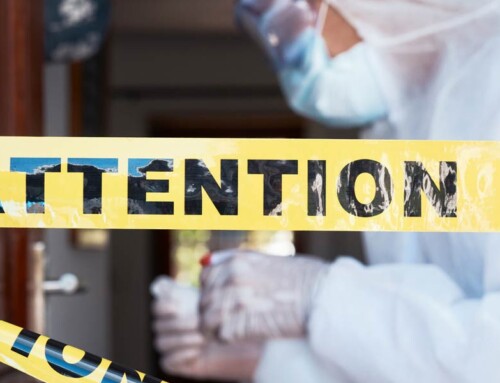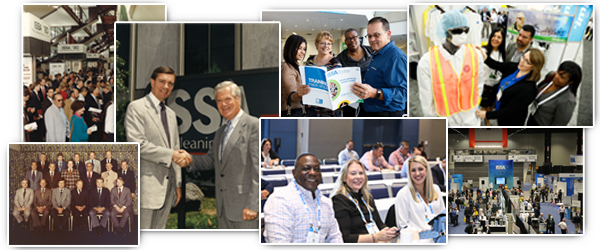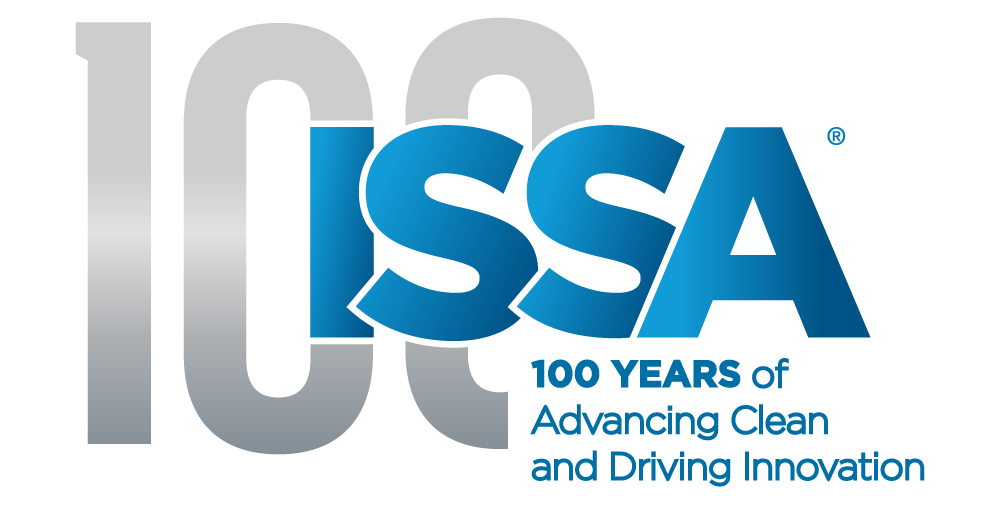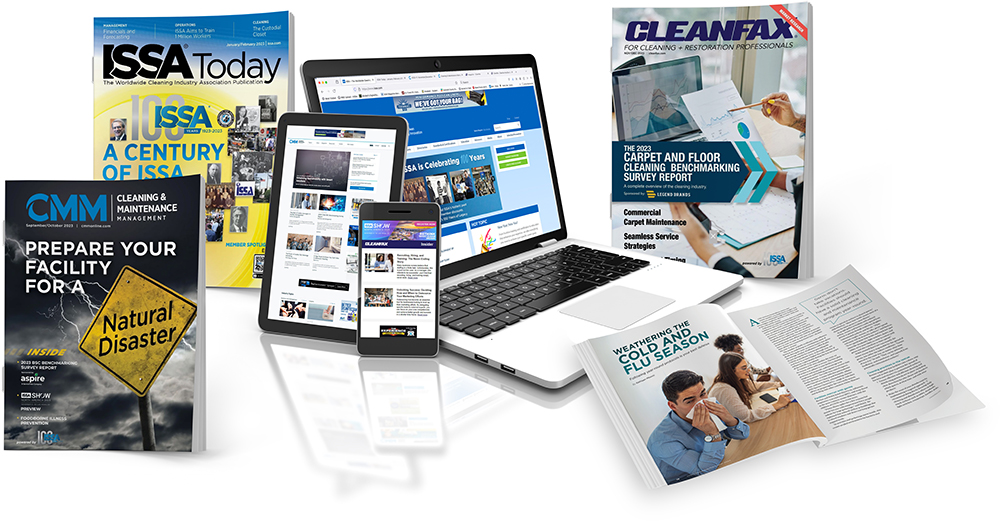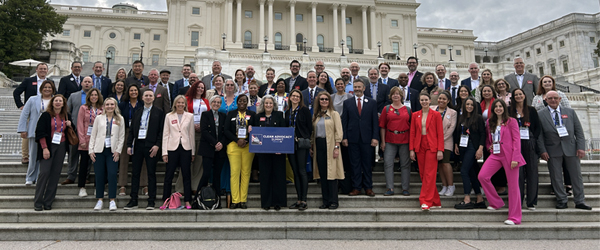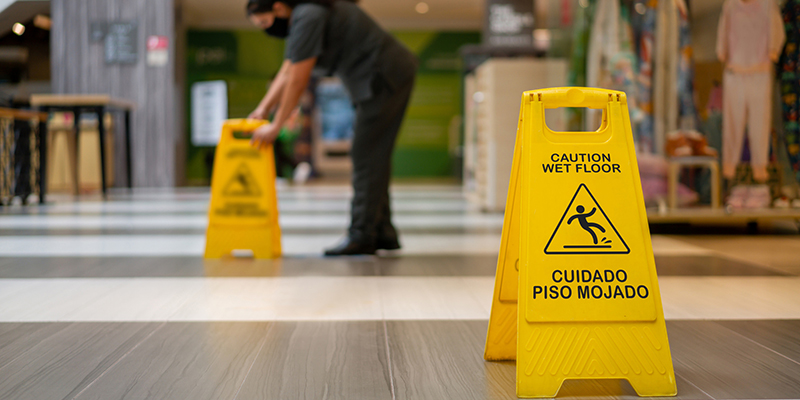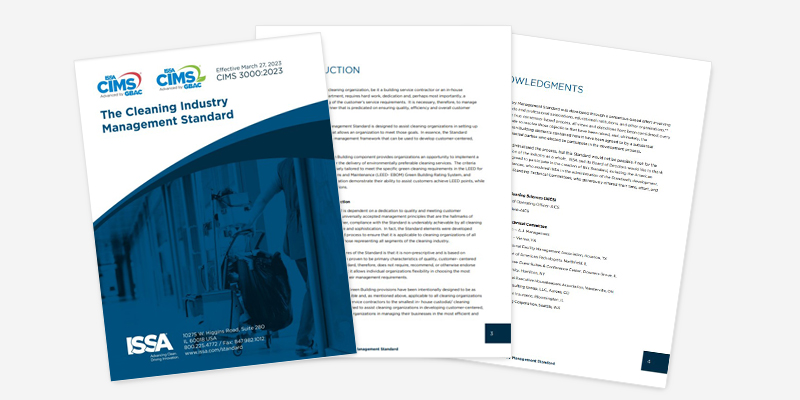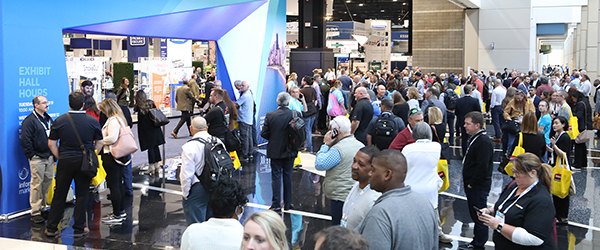Cleaner Spaces, Healthier Lives

The role of the person who cleans is one of health and safety. Dr. Michael A. Berry, in his book Protecting the Built Environment: Cleaning for Health, emphasized the critical role of effective cleaning in maintaining healthy indoor spaces. He explained that effective cleaning is the process of extracting and removing unwanted matter to the optimum extent to reduce exposure to unwanted matter.
In an article in the Journal of Cleaning, Restoration, & Inspection published in 2017, entitled Characteristics of High-Performance Carpet Cleaning, Dr. Berry stated his thoughts specific to floor cleaning. “Most people clean carpets when they look dirty. Rarely does anyone recognize that their carpet needs to be cleaned for health protection. Yet every time pollutants are extracted from the carpeting, the quality of the indoor environment is enhanced by reducing exposures.”
ISSA Cleaning for Health training course
Using the book by Dr. Michael A. Berry, Protecting the Built Environment: Cleaning for Health, we developed a three-hour in-person workshop that was conducted 54 times and trained 893 workers.
The workshop was developed by Dr. Gavin Macgregor-Skinner (ISSA), Doug Hoffman (NORMI), Dave Maurer (CPI), and Jim Mannes (Shaw Industries). Of the 893 workers that attended a workshop:
- Only 13% or 116 workers had received any training in the past five years (2018-2022).
- Many workers reported not having access to personal protective equipment (PPE) such as gloves, eye protection, or designated work clothes.
- The term “handle in accordance with good industrial hygiene and safety practice,” as stated on product safety data sheets, could not be defined as to what an individual should do.
- 90% or 804 workers could not recall one cleaning ingredient that was in a cleaning product they used at work.
ISSA Making Safer Choices project
ISSA is conducting cutting-edge research to determine how people make decisions when buying and using cleaning products. Using our research results, the project will develop community-designed “tool kits” and training programs in multiple languages to help people make safer choices and advocate for safer cleaning products to help protect the health of businesses, building occupants, and the environment.
ISSA is conducting this project in collaboration with Penn State College of Medicine (Dr. Rebecca Bascom) and The City University of New York (CUNY) School of Medicine (Dr. Omrana Pasha-Razzak). It is being funded by a US$1.2 million grant from the U.S. Environmental Protection Agency (EPA). In 2025, we aim to work with 1,000 facilities in Pennsylvania and New York and conduct on-site product demonstrations and training courses.
2024 Safer Choice Partner of the Year award winners
This prestigious award recognizes organizations significantly contributing to developing and commercializing safer chemicals and products. The Safer Choice Partner of the Year award highlights the commitment of ISSA and its members to promoting sustainable and environmentally friendly cleaning practices.
By partnering with Safer Choice, ISSA and its members have demonstrated their commitment to environmental sustainability and public health. This achievement is a testament to our members’ hard work and dedication and the positive impact they are making on the environment.
ISSA is proud to be associated with such innovative and committed organizations as Bona US, Church & Dwight Co. Inc., ECOS, EnvirOx LLC, Holloway House Inc., JAWS International Ltd.—a Division of Canberra Corporation, Jelmar LLC, McFadden and Associates LLC, Rust-Oleum Corporation, Seventh Generation Inc., Solutex Inc., SOZIO, Spartan Chemical Company Inc., State Industrial Products, The Clorox Company, The Home Depot, Procter & Gamble Company (P&G), Verde Clean, and WAXIE Sanitary Supply (BradyPlus).
The effectiveness of surface cleaning
There is excellent evidence in scientific literature that environmental contamination plays a significant role in the transmission of infectious diseases. It has been demonstrated that germs can survive on surfaces for days, weeks, months, and even years.
Although the process of selecting cleaning products is commonplace in facilities, there are very limited number of articles in peer-reviewed literature on this topic.
Cleaning is more than just removing dirt. It provides essential hygiene that supports and improves health and prevents the spread of illness.
Facility cleaning performance can no longer only be based on subjective visual inspection. Harmful contaminants and germs that can cause infections are not visible to the human eye.
Our role as professionals is to make the invisible visible. But before we measure, we need to understand what the unwanted matter is and whether this matter can have a negative health impact.
If it can, we are cleaning for health.
Better product information
In our training courses, we constantly remind workers to read the label and the manufacturer’s safety data sheet. In 2025, we are going to do better than that.
Consumers are looking for ways to clean well, at a good price, and without harming those who use the indoor space. Users of cleaning products find it difficult to identify and comprehend the varying types of information available for products found on store shelves and those they buy from distributors and wholesalers.
As companies provide essential products to society, we need to do better and provide useful information for all products using the technology available to us, such as videos, QR codes, RFID tags, smart labels, and digital product passports.
We are an industry that will be data-driven
People increasingly can, and are, sharing what they’re finding on a real-time basis through social media using photos and videos of dirty surfaces or indoor air quality (IAQ) monitors showing high carbon dioxide measurements, airborne particle levels, ozone, formaldehyde, and volatile organic compound (VOC) readings.
Several countries have created laws that require businesses to measure indoor carbon dioxide (CO₂) levels (a proxy for ventilation) and, in certain settings, display this information prominently. These have created expectations of screening, sensing, and sharing data that will not be reversed. Notable examples include:
Germany Technical Rules for Workplaces (ASR A3.6) stipulate that indoor CO₂ concentrations should not exceed 1,000 parts per million (ppm) in workplaces. If levels surpass this threshold, employers are required to take corrective actions, which may include increasing ventilation or reducing occupancy.
France Educational Institutions: Regulations mandate that schools and childcare facilities monitor indoor air quality, including CO₂ levels. The law requires periodic assessments, and if CO₂ concentrations exceed 1,000 ppm, measures must be implemented to improve ventilation.
Japan Building Standards Law includes provisions for indoor air quality, recommending that CO₂ concentrations in buildings should not exceed 1,000 ppm to ensure sufficient ventilation.
United Kingdom Schools and Workplaces: The UK Department for Education’s guidelines for school premises advise that CO₂ levels should not exceed 1,500 ppm during the occupied period. Similarly, the Health and Safety Executive (HSE) recommends that indoor CO₂ concentrations in workplaces be kept below 1,000 ppm to maintain good air quality.
These regulations underscore the importance of monitoring indoor CO₂ levels as an indicator of ventilation effectiveness and occupant health.
By adhering to these standards, businesses and institutions can ensure healthier indoor environments, and we expect to see these laws and guidelines expand in 2025.
ISSA is filling knowledge gaps
ISSA provides opportunities for members to learn and share knowledge and information across the industry.
The Cleaning Industry Management Standard (CIMS) program is designed to assist cleaning companies in establishing a management system that focuses on increasing the company’s quality, efficiency, and professionalism by providing employees and customers with a safer and healthier work environment.
The ISSA Clean Standards establishes a framework to help schools and facilities objectively assess the effectiveness of their cleaning processes using ATP swabs and audits based on the process of “Clean, Measure, Monitor.” The ISSA Clean Standards improve the built environment by setting levels of cleanliness that can be reasonably achieved, recommend monitoring and inspection procedures to measure the effectiveness of cleaning, and how to use the measurement and inspection results to assess and improve cleaning processes and products.
GBAC® STAR accredited facilities and organizations use their accreditation to support performance-based cleaning and demonstrate their commitment to health and wellness with science-based practices. GBAC STAR facilities are committed to establishing and sustaining a high-performance cleaning and maintenance program to maintain a safe and hygienic indoor environment while also shaping a healthier and safer world for everyone, everywhere. Their employees are knowledgeable and trained to uphold the highest cleaning and building maintenance standards.
The Cleaning Management Institute (CMI) was founded in 1964 and has certified more than 300,000 individuals worldwide. It has furthered the education and development of cleaning and maintenance professionals, managers, supervisors, and executives.
- The Accredited Auditing Professional (AAP) certification enhances knowledge and provides technical skills for quality assurance and to perform a building audit.
- The Certified Custodial Supervisor (C.C.S.) certification provides a comprehensive set of technical and soft skills for supervisors and managers, from leadership development to technical proficiency.
- The Certified Custodial Technician Basic and Advanced certification course provides hands-on and lecture-based education to ensure workers learn the most efficient and current best practices of daily/routine, interim/periodic, and restorative/periodic cleaning procedures.
The ISSA Sustainability Committee was established in 2022 to develop an accessible, credible, and enduring multifaceted sustainability program for the global cleaning industry. The Committee convenes volunteer leaders from the entire cleaning industry value chain to identify and develop resources members need (e.g., training and educational programs, reporting tools, understanding government requirements, design for circularity, extended producer responsibility—EPR, product lifecycle management) for organizational improvement and responding to customers’ sustainability requests.
The future is clean
One of the amazing things about the work we do at ISSA is being able to bring the entire industry value chain of companies together.
ISSA does this to advance the importance of thorough cleaning practices in safeguarding the health of building occupants. Cleaning helps people lead healthier lives.
Through education, innovation, and our ability to convene, ISSA is leading a movement toward making safer choices for a clean, healthy, sustainable world.
Dr. Gavin Macgregor-Skinner is the senior director of the Global Biorisk Advisory Council® (GBAC), a division of ISSA. As an infection prevention expert and university professor, he works to develop protocols and education for the global cleaning industry to empower facilities, businesses, and cleaning professionals to create safe and healthy environments.
References:
Berry, M.A., Protecting the Built Environment: Cleaning for Health. 1993, Chapel Hill, NC; Tricomm 21st Press.
Berry, M.A., Characteristics of High-Performance Carpet Cleaning, Winter 2017 Journal of Cleaning, Restoration & Inspection, IICRC.
Cole, E.C., Franke, D.L., Leese, K.E., Dulaney, P.D., Foarde, K.K., Green D.A., Hall R.M., and Berry, M. Indoor Environment Characterization of a Non-Problem Building: Assessment of Cleaning Effectiveness. Research Triangle Report (RTI) Number 94U-4479-014, Research Triangle Institute, Research Triangle, North Carolina. 202 pages. March 1994.
Rutala, W.A., Weber, D.J. Monitoring and improving the effectiveness of surface cleaning and disinfection. Am J Infect Control. 2016 May 2;44(5 Suppl): e69-76.


